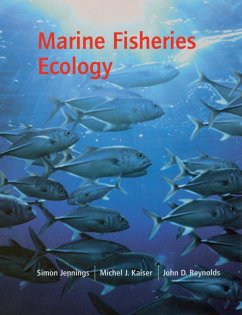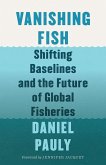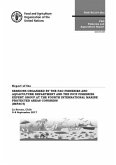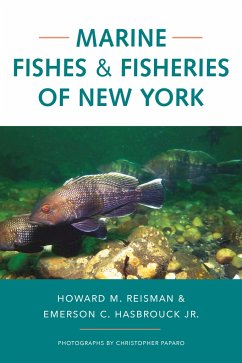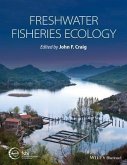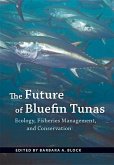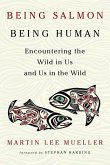Simon Jennings (CEFAS Lowestoft), Michel Kaiser (Bangor University of Wales), John D. Reynolds (Simon Fraser University)
Marine Fisheries Ecology
Simon Jennings (CEFAS Lowestoft), Michel Kaiser (Bangor University of Wales), John D. Reynolds (Simon Fraser University)
Marine Fisheries Ecology
- Broschiertes Buch
- Merkliste
- Auf die Merkliste
- Bewerten Bewerten
- Teilen
- Produkt teilen
- Produkterinnerung
- Produkterinnerung
CLICK HERE TO DOWNLOAD ARTWORK
This topical and exciting textbook describes fisheries exploitation, biology, conservation and management, and reflects many recent and important changes in fisheries science.
This text describes fisheries exploitation, biology, conservation and management, and reflects many recent and important changes in fisheries science, including growing concerns about the environmental impact of fisheries.
Andere Kunden interessierten sich auch für
![Tropical Estuarine Fishes Tropical Estuarine Fishes]() Stephen J. M. Blaber (CSIRO Marine Research, Cleveland, Queensland,Tropical Estuarine Fishes327,99 €
Stephen J. M. Blaber (CSIRO Marine Research, Cleveland, Queensland,Tropical Estuarine Fishes327,99 €![Vanishing Fish: Shifting Baselines and the Future of Global Fisheries Vanishing Fish: Shifting Baselines and the Future of Global Fisheries]() Daniel PaulyVanishing Fish: Shifting Baselines and the Future of Global Fisheries30,99 €
Daniel PaulyVanishing Fish: Shifting Baselines and the Future of Global Fisheries30,99 €![Report of the Sessions Organized by the Fao Fisheries and Aquaculture Department and the Iucn Fisheries Expert Group at the Fourth International Marine Protected Areas Congress (Impac4) Report of the Sessions Organized by the Fao Fisheries and Aquaculture Department and the Iucn Fisheries Expert Group at the Fourth International Marine Protected Areas Congress (Impac4)]() Food and Agriculture OrganizationReport of the Sessions Organized by the Fao Fisheries and Aquaculture Department and the Iucn Fisheries Expert Group at the Fourth International Marine Protected Areas Congress (Impac4)21,99 €
Food and Agriculture OrganizationReport of the Sessions Organized by the Fao Fisheries and Aquaculture Department and the Iucn Fisheries Expert Group at the Fourth International Marine Protected Areas Congress (Impac4)21,99 €![Marine Fishes and Fisheries of New York Marine Fishes and Fisheries of New York]() Howard M. ReismanMarine Fishes and Fisheries of New York26,99 €
Howard M. ReismanMarine Fishes and Fisheries of New York26,99 €![Freshwater Fisheries Ecology Freshwater Fisheries Ecology]() Freshwater Fisheries Ecology137,99 €
Freshwater Fisheries Ecology137,99 €![The Future of Bluefin Tunas The Future of Bluefin Tunas]() The Future of Bluefin Tunas136,99 €
The Future of Bluefin Tunas136,99 €![Being Salmon, Being Human Being Salmon, Being Human]() Martin Lee MuellerBeing Salmon, Being Human26,99 €
Martin Lee MuellerBeing Salmon, Being Human26,99 €-
-
-
CLICK HERE TO DOWNLOAD ARTWORK
This topical and exciting textbook describes fisheries exploitation, biology, conservation and management, and reflects many recent and important changes in fisheries science.
This text describes fisheries exploitation, biology, conservation and management, and reflects many recent and important changes in fisheries science, including growing concerns about the environmental impact of fisheries.
Hinweis: Dieser Artikel kann nur an eine deutsche Lieferadresse ausgeliefert werden.
This topical and exciting textbook describes fisheries exploitation, biology, conservation and management, and reflects many recent and important changes in fisheries science.
This text describes fisheries exploitation, biology, conservation and management, and reflects many recent and important changes in fisheries science, including growing concerns about the environmental impact of fisheries.
Hinweis: Dieser Artikel kann nur an eine deutsche Lieferadresse ausgeliefert werden.
Produktdetails
- Produktdetails
- Verlag: Blackwell Publishers
- Seitenzahl: 432
- Erscheinungstermin: 30. März 2001
- Englisch
- Abmessung: 246mm x 189mm x 24mm
- Gewicht: 726g
- ISBN-13: 9780632050987
- ISBN-10: 0632050985
- Artikelnr.: 14504933
- Herstellerkennzeichnung
- Libri GmbH
- Europaallee 1
- 36244 Bad Hersfeld
- gpsr@libri.de
- Verlag: Blackwell Publishers
- Seitenzahl: 432
- Erscheinungstermin: 30. März 2001
- Englisch
- Abmessung: 246mm x 189mm x 24mm
- Gewicht: 726g
- ISBN-13: 9780632050987
- ISBN-10: 0632050985
- Artikelnr.: 14504933
- Herstellerkennzeichnung
- Libri GmbH
- Europaallee 1
- 36244 Bad Hersfeld
- gpsr@libri.de
Simon Jennings and Michel Kaiser are the authors of Marine Fisheries Ecology, published by Wiley.
Preface ix
Acknowledgements xii
1 Marine fisheries ecology: an introduction 1
1.1 Introduction 1
1.2 Fisheries of the world 1
1.2.1 History of fisheries 1
1.2.2 Fishery science 6
1.2.3 Diversity of fisheries 7
1.3 Patterns of exploitation 9
1.3.1 Boom and bust 9
1.3.2 Conservation and ecosystem concerns 14
1.4 Why manage fisheries? 14
1.5 Objectives of management 15
1.5.1 Range of objectives 15
1.5.2 Balancing objectives 16
1.5.3 From objective to action 17
1.6 Meeting management objectives 17
1.7 Structure of this book 18
Summary 20
2 Marine ecology and production processes 21
2.1 Introduction 21
2.2 Primary production: sources and magnitude 21
2.3 Phytoplanktonic production 22
2.3.1 Links between production and physical processes 22
2.3.2 Upwellings and fronts 24
2.3.3 Rates of phytoplanktonic production 25
2.4 Non-phytoplanktonic production 28
2.4.1 Macroalgae 28
2.4.2 Mangroves 29
2.4.3 Coral reef algae 29
2.4.4 Seagrasses and marsh plants 30
2.4.5 Microphytobenthos 31
2.5 Heterotrophic production 31
2.5.1 The fate of primary production 31
2.5.2 Transfer along the food chain 32
2.5.3 Production of fished species 34
2.5.4 Linking primary production and landings 37
Summary 38
3 Fished species life histories and distribution 39
3.1 Introduction 39
3.2 Fishes 39
3.3 Invertebrates 41
3.4 Life histories 55
3.4.1 Sex sex reversal and sex ratios 55
3.4.2 Growth maturity and longevity 56
3.4.3 Egg size fecundity and reproduction 59
3.5 Distribution in space and time 62
3.5.1 Geographical ranges and stock structures 62
3.5.2 Migration 62
3.5.3 Larval transport retention and dispersal 65
3.5.4 Metapopulations 68
Summary 69
4 Population structure in space and time 70
4.1 Introduction 70
4.2 Recruitment 70
4.2.1 Spawner and recruit relationships 71
4.2.2 Mortality during the early life history 78
4.2.3 Depensation 83
4.2.4 Regulation in fish populations 85
4.3 Density-dependent habitat use 86
Summary 88
5 Fishing gears and techniques 90
5.1 Introduction 90
5.2 From shoreline gathering to satellites 90
5.3 Modern commercial fishing gears 94
5.3.1 Towed fishing gear 95
5.3.2 Static fishing gear 103
5.4 Other fishing techniques 106
5.5 Conservation methods 108
Summary 111
6 Fishers: socioeconomics and human ecology 112
6.1 Introduction 112
6.2 Motivations for fishing 112
6.2.1 Food 112
6.2.2 Income 113
6.3 Modifications to fishing behaviour 115
6.3.1 Social 115
6.3.2 Religion 117
6.4 Conflicts and conflict resolution 118
6.4.1 Competing for fish 118
6.4.2 Fish wars 121
6.4.3 Fishers in the political process 122
6.4.4 Traditional management systems 123
6.4.5 Customary marine tenure 124
6.4.6 Co-management 125
Summary 126
7 Single-species stock assessment 127
7.1 Introduction 127
7.2 Balancing birth and death 127
7.3 Surplus production models 128
7.3.1 Stability 128
7.3.2 Models of population growth 130
7.3.3 Fitting models to data 130
7.3.4 Surplus production models in action 132
7.4 Delay-difference models 135
7.4.1 Delay-difference models in action 137
7.5 Virtual population analysis 138
7.5.1 Age-based cohort analysis 140
7.5.2 Length-based cohort analysis 143
7.6 Statistical catch-at-age methods 144
7.7 Yield-per-recruit models 145
7.7.1 Yield-per-recruit models in action 146
7.8 Incorporating recruitment 149
7.8.1 Replacement lines 149
7.8.2 Replacement lines in action 150
7.9 Confronting risk and uncertainty 152
7.9.1 Bayesian analysis 153
7.9.2 Resampling methods 154
7.10 Biological reference points 155
Summary 157
8 Multispecies assessment and ecosystem modelling 159
8.1 Introduction 159
8.2 Multispecies surplus production 159
8.2.1 Multispecies surplus production in action 160
8.3 Multispecies yield per recruit 162
8.3.1 Multispecies yield per recruit in action 162
8.4 Multispecies virtual population analysis 162
8.4.1 Multispecies VPA in action 164
8.4.2 Applying MSVPA data to single-species model 169
8.5 Predators prey and competitors 169
8.5.1 Predator-prey dynamics 169
8.5.2 Competition an unexpected result 170
8.5.3 Management implications 171
8.6 Size spectra 171
8.7 Ecosystem models 173
8.7.1 Ecosystem models in action 174
Summary 177
9 Getting the data: stock identity and dynamics 178
9.1 Introduction 178
9.2 Stock identification 178
9.2.1 The stock concept 178
9.2.2 Methods of stock identification 178
9.3 Stock dynamics 184
9.3.1 Sampling 184
9.3.2 Length weight and age 189
9.3.3 Growth 195
9.3.4 Maturity 199
9.3.5 Fecundity 199
9.3.6 Mortality 201
9.4 The impact of errors 203
Summary 204
10 Getting the data: abundance catch and effort 205
10.1 Introduction 205
10.2 Abundance 205
10.2.1 Survey design 205
10.2.2 Visual census methods 206
10.2.3 Acoustic methods 209
10.2.4 Trawl surveys 210
10.2.5 Depletion methods 213
10.2.6 Mark-recapture methods 214
10.2.7 Egg production methods 214
10.3 The fishery 219
Summary 221
11 Bioeconomics 223
11.1 Introduction 223
11.2 The value of fisheries 223
11.2.1 Trade in fished species 223
11.2.2 Catch values and employment 224
11.3 Bioeconomic models 225
11.3.1 Descriptive bioeconomics 226
11.3.2 Optimal fishing strategies 230
11.3.3 Bayesian methods 235
11.4 Economic vs. social management objectives 237
11.4.1 Subsidies 237
11.4.2 The case for economic efficiency 237
Summary 238
12 Fishing effects on populations and communities 239
12.1 Introduction 239
12.2 Vulnerability to fishing 239
12.2.1 Behaviour 239
12.2.2 Life histories 241
12.3 Intraspecific effects 242
12.3.1 Age and size structure 242
12.3.2 Reproduction 243
12.3.3 Genetic structure 244
12.4 Community effects 245
12.4.1 Diversity 245
12.4.2 Community structure 250
12.4.3 Size structure 251
12.4.4 Competition and trophic interactions 252
Summary 256
13 Bycatches and discards 258
13.1 Introduction 258
13.2 Catches discards and bycatches 258
13.2.1 Definitions 258
13.2.2 Reasons for discarding 258
13.3 Alternatives to discarding 260
13.4 Fisheries and bycatches 260
13.5 Incidental captures 262
13.5.1 Seabirds 262
13.5.2 Sea turtles 264
13.5.3 Sea snakes 265
13.5.4 Marine mammals 265
13.6 Methods to reduce bycatches 267
13.7 Ghost fishing 267
13.8 Sociocultural differences 270
Summary 271
14 Impacts on benthic communities habitats and coral reefs 272
14.1 Introduction 272
14.2 Fishing disturbance 272
14.2.1 Fishing vs. natural disturbance 272
14.2.2 Distribution of fishing disturbance 273
14.3 Direct effects of fishing gear on the seabed 276
14.3.1 Towed fishing gear 276
14.3.2 Direct effects on the substratum 277
14.3.3 Effects on infauna 277
14.3.4 Effects on epifauna 281
14.3.5 Meta-analysis 284
14.4 Effects of static fishing gears 284
14.5 Long-term effects 285
14.6 Fishing as a source of energy subsidies 288
14.6.1 Have population changes occurred? 290
14.7 Indirect effects on habitats 290
14.7.1 Loose seabeds 290
14.7.2 Coral reefs 291
Summary 293
15 Fishery interactions with birds and mammals 294
15.1 Introduction 294
15.2 Birds 294
15.2.1 Competition between birds and fisheries 296
15.2.2 Benefits of discarding 300
15.2.3 Waders and shellfish 301
15.3 Mammals 303
15.3.1 Competition between mammals and fisheries 304
15.3.2 Prey release 307
Summary 309
16 A role for aquaculture? 310
16.1 Introduction 310
16.2 Aquaculture past and present 310
16.3 What is cultivated? 312
16.4 Production systems 313
16.5 Feeding constraints 314
16.6 Prospects for expansion 314
16.6.1 Cage cultivation 316
16.6.2 Stock enhancement and ranching 318
16.7 Case studies 319
16.7.1 Shrimp farming 319
16.7.2 Bivalve mariculture 322
Summary 326
17 Management and conservation options 327
17.1 Introduction 327
17.2 Management objectives strategies and actions 327
17.2.1 From objective to action 327
17.2.2 Catch control 328
17.2.3 Effort control 331
17.2.4 Technical measures 331
17.2.5 Management in action 332
17.3 Improving management 335
17.3.1 Enforcement and compliance 335
17.3.2 Co-management 337
17.3.3 Ownership of resources and harvesting rights 338
17.3.4 Uncertainty and the precautionary approach 338
17.3.5 Role of science 339
17.4 Multispecies and ecosystem-based management 341
17.4.1 What are the objectives? 341
17.4.2 What can be achieved? 341
17.5 Managing fisheries for conservation 342
17.5.1 Endangered species 342
17.5.2 Habitats 343
17.5.3 Protected areas and no-take zones 344
17.6 Future trends 346
17.6.1 Fisheries science 346
17.6.2 Fisheries management 346
Summary 347
References 348
Appendices
1 List of symbols 380
2 Fisheries websites 385
3 Geographic index 389
Index 393
Acknowledgements xii
1 Marine fisheries ecology: an introduction 1
1.1 Introduction 1
1.2 Fisheries of the world 1
1.2.1 History of fisheries 1
1.2.2 Fishery science 6
1.2.3 Diversity of fisheries 7
1.3 Patterns of exploitation 9
1.3.1 Boom and bust 9
1.3.2 Conservation and ecosystem concerns 14
1.4 Why manage fisheries? 14
1.5 Objectives of management 15
1.5.1 Range of objectives 15
1.5.2 Balancing objectives 16
1.5.3 From objective to action 17
1.6 Meeting management objectives 17
1.7 Structure of this book 18
Summary 20
2 Marine ecology and production processes 21
2.1 Introduction 21
2.2 Primary production: sources and magnitude 21
2.3 Phytoplanktonic production 22
2.3.1 Links between production and physical processes 22
2.3.2 Upwellings and fronts 24
2.3.3 Rates of phytoplanktonic production 25
2.4 Non-phytoplanktonic production 28
2.4.1 Macroalgae 28
2.4.2 Mangroves 29
2.4.3 Coral reef algae 29
2.4.4 Seagrasses and marsh plants 30
2.4.5 Microphytobenthos 31
2.5 Heterotrophic production 31
2.5.1 The fate of primary production 31
2.5.2 Transfer along the food chain 32
2.5.3 Production of fished species 34
2.5.4 Linking primary production and landings 37
Summary 38
3 Fished species life histories and distribution 39
3.1 Introduction 39
3.2 Fishes 39
3.3 Invertebrates 41
3.4 Life histories 55
3.4.1 Sex sex reversal and sex ratios 55
3.4.2 Growth maturity and longevity 56
3.4.3 Egg size fecundity and reproduction 59
3.5 Distribution in space and time 62
3.5.1 Geographical ranges and stock structures 62
3.5.2 Migration 62
3.5.3 Larval transport retention and dispersal 65
3.5.4 Metapopulations 68
Summary 69
4 Population structure in space and time 70
4.1 Introduction 70
4.2 Recruitment 70
4.2.1 Spawner and recruit relationships 71
4.2.2 Mortality during the early life history 78
4.2.3 Depensation 83
4.2.4 Regulation in fish populations 85
4.3 Density-dependent habitat use 86
Summary 88
5 Fishing gears and techniques 90
5.1 Introduction 90
5.2 From shoreline gathering to satellites 90
5.3 Modern commercial fishing gears 94
5.3.1 Towed fishing gear 95
5.3.2 Static fishing gear 103
5.4 Other fishing techniques 106
5.5 Conservation methods 108
Summary 111
6 Fishers: socioeconomics and human ecology 112
6.1 Introduction 112
6.2 Motivations for fishing 112
6.2.1 Food 112
6.2.2 Income 113
6.3 Modifications to fishing behaviour 115
6.3.1 Social 115
6.3.2 Religion 117
6.4 Conflicts and conflict resolution 118
6.4.1 Competing for fish 118
6.4.2 Fish wars 121
6.4.3 Fishers in the political process 122
6.4.4 Traditional management systems 123
6.4.5 Customary marine tenure 124
6.4.6 Co-management 125
Summary 126
7 Single-species stock assessment 127
7.1 Introduction 127
7.2 Balancing birth and death 127
7.3 Surplus production models 128
7.3.1 Stability 128
7.3.2 Models of population growth 130
7.3.3 Fitting models to data 130
7.3.4 Surplus production models in action 132
7.4 Delay-difference models 135
7.4.1 Delay-difference models in action 137
7.5 Virtual population analysis 138
7.5.1 Age-based cohort analysis 140
7.5.2 Length-based cohort analysis 143
7.6 Statistical catch-at-age methods 144
7.7 Yield-per-recruit models 145
7.7.1 Yield-per-recruit models in action 146
7.8 Incorporating recruitment 149
7.8.1 Replacement lines 149
7.8.2 Replacement lines in action 150
7.9 Confronting risk and uncertainty 152
7.9.1 Bayesian analysis 153
7.9.2 Resampling methods 154
7.10 Biological reference points 155
Summary 157
8 Multispecies assessment and ecosystem modelling 159
8.1 Introduction 159
8.2 Multispecies surplus production 159
8.2.1 Multispecies surplus production in action 160
8.3 Multispecies yield per recruit 162
8.3.1 Multispecies yield per recruit in action 162
8.4 Multispecies virtual population analysis 162
8.4.1 Multispecies VPA in action 164
8.4.2 Applying MSVPA data to single-species model 169
8.5 Predators prey and competitors 169
8.5.1 Predator-prey dynamics 169
8.5.2 Competition an unexpected result 170
8.5.3 Management implications 171
8.6 Size spectra 171
8.7 Ecosystem models 173
8.7.1 Ecosystem models in action 174
Summary 177
9 Getting the data: stock identity and dynamics 178
9.1 Introduction 178
9.2 Stock identification 178
9.2.1 The stock concept 178
9.2.2 Methods of stock identification 178
9.3 Stock dynamics 184
9.3.1 Sampling 184
9.3.2 Length weight and age 189
9.3.3 Growth 195
9.3.4 Maturity 199
9.3.5 Fecundity 199
9.3.6 Mortality 201
9.4 The impact of errors 203
Summary 204
10 Getting the data: abundance catch and effort 205
10.1 Introduction 205
10.2 Abundance 205
10.2.1 Survey design 205
10.2.2 Visual census methods 206
10.2.3 Acoustic methods 209
10.2.4 Trawl surveys 210
10.2.5 Depletion methods 213
10.2.6 Mark-recapture methods 214
10.2.7 Egg production methods 214
10.3 The fishery 219
Summary 221
11 Bioeconomics 223
11.1 Introduction 223
11.2 The value of fisheries 223
11.2.1 Trade in fished species 223
11.2.2 Catch values and employment 224
11.3 Bioeconomic models 225
11.3.1 Descriptive bioeconomics 226
11.3.2 Optimal fishing strategies 230
11.3.3 Bayesian methods 235
11.4 Economic vs. social management objectives 237
11.4.1 Subsidies 237
11.4.2 The case for economic efficiency 237
Summary 238
12 Fishing effects on populations and communities 239
12.1 Introduction 239
12.2 Vulnerability to fishing 239
12.2.1 Behaviour 239
12.2.2 Life histories 241
12.3 Intraspecific effects 242
12.3.1 Age and size structure 242
12.3.2 Reproduction 243
12.3.3 Genetic structure 244
12.4 Community effects 245
12.4.1 Diversity 245
12.4.2 Community structure 250
12.4.3 Size structure 251
12.4.4 Competition and trophic interactions 252
Summary 256
13 Bycatches and discards 258
13.1 Introduction 258
13.2 Catches discards and bycatches 258
13.2.1 Definitions 258
13.2.2 Reasons for discarding 258
13.3 Alternatives to discarding 260
13.4 Fisheries and bycatches 260
13.5 Incidental captures 262
13.5.1 Seabirds 262
13.5.2 Sea turtles 264
13.5.3 Sea snakes 265
13.5.4 Marine mammals 265
13.6 Methods to reduce bycatches 267
13.7 Ghost fishing 267
13.8 Sociocultural differences 270
Summary 271
14 Impacts on benthic communities habitats and coral reefs 272
14.1 Introduction 272
14.2 Fishing disturbance 272
14.2.1 Fishing vs. natural disturbance 272
14.2.2 Distribution of fishing disturbance 273
14.3 Direct effects of fishing gear on the seabed 276
14.3.1 Towed fishing gear 276
14.3.2 Direct effects on the substratum 277
14.3.3 Effects on infauna 277
14.3.4 Effects on epifauna 281
14.3.5 Meta-analysis 284
14.4 Effects of static fishing gears 284
14.5 Long-term effects 285
14.6 Fishing as a source of energy subsidies 288
14.6.1 Have population changes occurred? 290
14.7 Indirect effects on habitats 290
14.7.1 Loose seabeds 290
14.7.2 Coral reefs 291
Summary 293
15 Fishery interactions with birds and mammals 294
15.1 Introduction 294
15.2 Birds 294
15.2.1 Competition between birds and fisheries 296
15.2.2 Benefits of discarding 300
15.2.3 Waders and shellfish 301
15.3 Mammals 303
15.3.1 Competition between mammals and fisheries 304
15.3.2 Prey release 307
Summary 309
16 A role for aquaculture? 310
16.1 Introduction 310
16.2 Aquaculture past and present 310
16.3 What is cultivated? 312
16.4 Production systems 313
16.5 Feeding constraints 314
16.6 Prospects for expansion 314
16.6.1 Cage cultivation 316
16.6.2 Stock enhancement and ranching 318
16.7 Case studies 319
16.7.1 Shrimp farming 319
16.7.2 Bivalve mariculture 322
Summary 326
17 Management and conservation options 327
17.1 Introduction 327
17.2 Management objectives strategies and actions 327
17.2.1 From objective to action 327
17.2.2 Catch control 328
17.2.3 Effort control 331
17.2.4 Technical measures 331
17.2.5 Management in action 332
17.3 Improving management 335
17.3.1 Enforcement and compliance 335
17.3.2 Co-management 337
17.3.3 Ownership of resources and harvesting rights 338
17.3.4 Uncertainty and the precautionary approach 338
17.3.5 Role of science 339
17.4 Multispecies and ecosystem-based management 341
17.4.1 What are the objectives? 341
17.4.2 What can be achieved? 341
17.5 Managing fisheries for conservation 342
17.5.1 Endangered species 342
17.5.2 Habitats 343
17.5.3 Protected areas and no-take zones 344
17.6 Future trends 346
17.6.1 Fisheries science 346
17.6.2 Fisheries management 346
Summary 347
References 348
Appendices
1 List of symbols 380
2 Fisheries websites 385
3 Geographic index 389
Index 393
Preface ix
Acknowledgements xii
1 Marine fisheries ecology: an introduction 1
1.1 Introduction 1
1.2 Fisheries of the world 1
1.2.1 History of fisheries 1
1.2.2 Fishery science 6
1.2.3 Diversity of fisheries 7
1.3 Patterns of exploitation 9
1.3.1 Boom and bust 9
1.3.2 Conservation and ecosystem concerns 14
1.4 Why manage fisheries? 14
1.5 Objectives of management 15
1.5.1 Range of objectives 15
1.5.2 Balancing objectives 16
1.5.3 From objective to action 17
1.6 Meeting management objectives 17
1.7 Structure of this book 18
Summary 20
2 Marine ecology and production processes 21
2.1 Introduction 21
2.2 Primary production: sources and magnitude 21
2.3 Phytoplanktonic production 22
2.3.1 Links between production and physical processes 22
2.3.2 Upwellings and fronts 24
2.3.3 Rates of phytoplanktonic production 25
2.4 Non-phytoplanktonic production 28
2.4.1 Macroalgae 28
2.4.2 Mangroves 29
2.4.3 Coral reef algae 29
2.4.4 Seagrasses and marsh plants 30
2.4.5 Microphytobenthos 31
2.5 Heterotrophic production 31
2.5.1 The fate of primary production 31
2.5.2 Transfer along the food chain 32
2.5.3 Production of fished species 34
2.5.4 Linking primary production and landings 37
Summary 38
3 Fished species life histories and distribution 39
3.1 Introduction 39
3.2 Fishes 39
3.3 Invertebrates 41
3.4 Life histories 55
3.4.1 Sex sex reversal and sex ratios 55
3.4.2 Growth maturity and longevity 56
3.4.3 Egg size fecundity and reproduction 59
3.5 Distribution in space and time 62
3.5.1 Geographical ranges and stock structures 62
3.5.2 Migration 62
3.5.3 Larval transport retention and dispersal 65
3.5.4 Metapopulations 68
Summary 69
4 Population structure in space and time 70
4.1 Introduction 70
4.2 Recruitment 70
4.2.1 Spawner and recruit relationships 71
4.2.2 Mortality during the early life history 78
4.2.3 Depensation 83
4.2.4 Regulation in fish populations 85
4.3 Density-dependent habitat use 86
Summary 88
5 Fishing gears and techniques 90
5.1 Introduction 90
5.2 From shoreline gathering to satellites 90
5.3 Modern commercial fishing gears 94
5.3.1 Towed fishing gear 95
5.3.2 Static fishing gear 103
5.4 Other fishing techniques 106
5.5 Conservation methods 108
Summary 111
6 Fishers: socioeconomics and human ecology 112
6.1 Introduction 112
6.2 Motivations for fishing 112
6.2.1 Food 112
6.2.2 Income 113
6.3 Modifications to fishing behaviour 115
6.3.1 Social 115
6.3.2 Religion 117
6.4 Conflicts and conflict resolution 118
6.4.1 Competing for fish 118
6.4.2 Fish wars 121
6.4.3 Fishers in the political process 122
6.4.4 Traditional management systems 123
6.4.5 Customary marine tenure 124
6.4.6 Co-management 125
Summary 126
7 Single-species stock assessment 127
7.1 Introduction 127
7.2 Balancing birth and death 127
7.3 Surplus production models 128
7.3.1 Stability 128
7.3.2 Models of population growth 130
7.3.3 Fitting models to data 130
7.3.4 Surplus production models in action 132
7.4 Delay-difference models 135
7.4.1 Delay-difference models in action 137
7.5 Virtual population analysis 138
7.5.1 Age-based cohort analysis 140
7.5.2 Length-based cohort analysis 143
7.6 Statistical catch-at-age methods 144
7.7 Yield-per-recruit models 145
7.7.1 Yield-per-recruit models in action 146
7.8 Incorporating recruitment 149
7.8.1 Replacement lines 149
7.8.2 Replacement lines in action 150
7.9 Confronting risk and uncertainty 152
7.9.1 Bayesian analysis 153
7.9.2 Resampling methods 154
7.10 Biological reference points 155
Summary 157
8 Multispecies assessment and ecosystem modelling 159
8.1 Introduction 159
8.2 Multispecies surplus production 159
8.2.1 Multispecies surplus production in action 160
8.3 Multispecies yield per recruit 162
8.3.1 Multispecies yield per recruit in action 162
8.4 Multispecies virtual population analysis 162
8.4.1 Multispecies VPA in action 164
8.4.2 Applying MSVPA data to single-species model 169
8.5 Predators prey and competitors 169
8.5.1 Predator-prey dynamics 169
8.5.2 Competition an unexpected result 170
8.5.3 Management implications 171
8.6 Size spectra 171
8.7 Ecosystem models 173
8.7.1 Ecosystem models in action 174
Summary 177
9 Getting the data: stock identity and dynamics 178
9.1 Introduction 178
9.2 Stock identification 178
9.2.1 The stock concept 178
9.2.2 Methods of stock identification 178
9.3 Stock dynamics 184
9.3.1 Sampling 184
9.3.2 Length weight and age 189
9.3.3 Growth 195
9.3.4 Maturity 199
9.3.5 Fecundity 199
9.3.6 Mortality 201
9.4 The impact of errors 203
Summary 204
10 Getting the data: abundance catch and effort 205
10.1 Introduction 205
10.2 Abundance 205
10.2.1 Survey design 205
10.2.2 Visual census methods 206
10.2.3 Acoustic methods 209
10.2.4 Trawl surveys 210
10.2.5 Depletion methods 213
10.2.6 Mark-recapture methods 214
10.2.7 Egg production methods 214
10.3 The fishery 219
Summary 221
11 Bioeconomics 223
11.1 Introduction 223
11.2 The value of fisheries 223
11.2.1 Trade in fished species 223
11.2.2 Catch values and employment 224
11.3 Bioeconomic models 225
11.3.1 Descriptive bioeconomics 226
11.3.2 Optimal fishing strategies 230
11.3.3 Bayesian methods 235
11.4 Economic vs. social management objectives 237
11.4.1 Subsidies 237
11.4.2 The case for economic efficiency 237
Summary 238
12 Fishing effects on populations and communities 239
12.1 Introduction 239
12.2 Vulnerability to fishing 239
12.2.1 Behaviour 239
12.2.2 Life histories 241
12.3 Intraspecific effects 242
12.3.1 Age and size structure 242
12.3.2 Reproduction 243
12.3.3 Genetic structure 244
12.4 Community effects 245
12.4.1 Diversity 245
12.4.2 Community structure 250
12.4.3 Size structure 251
12.4.4 Competition and trophic interactions 252
Summary 256
13 Bycatches and discards 258
13.1 Introduction 258
13.2 Catches discards and bycatches 258
13.2.1 Definitions 258
13.2.2 Reasons for discarding 258
13.3 Alternatives to discarding 260
13.4 Fisheries and bycatches 260
13.5 Incidental captures 262
13.5.1 Seabirds 262
13.5.2 Sea turtles 264
13.5.3 Sea snakes 265
13.5.4 Marine mammals 265
13.6 Methods to reduce bycatches 267
13.7 Ghost fishing 267
13.8 Sociocultural differences 270
Summary 271
14 Impacts on benthic communities habitats and coral reefs 272
14.1 Introduction 272
14.2 Fishing disturbance 272
14.2.1 Fishing vs. natural disturbance 272
14.2.2 Distribution of fishing disturbance 273
14.3 Direct effects of fishing gear on the seabed 276
14.3.1 Towed fishing gear 276
14.3.2 Direct effects on the substratum 277
14.3.3 Effects on infauna 277
14.3.4 Effects on epifauna 281
14.3.5 Meta-analysis 284
14.4 Effects of static fishing gears 284
14.5 Long-term effects 285
14.6 Fishing as a source of energy subsidies 288
14.6.1 Have population changes occurred? 290
14.7 Indirect effects on habitats 290
14.7.1 Loose seabeds 290
14.7.2 Coral reefs 291
Summary 293
15 Fishery interactions with birds and mammals 294
15.1 Introduction 294
15.2 Birds 294
15.2.1 Competition between birds and fisheries 296
15.2.2 Benefits of discarding 300
15.2.3 Waders and shellfish 301
15.3 Mammals 303
15.3.1 Competition between mammals and fisheries 304
15.3.2 Prey release 307
Summary 309
16 A role for aquaculture? 310
16.1 Introduction 310
16.2 Aquaculture past and present 310
16.3 What is cultivated? 312
16.4 Production systems 313
16.5 Feeding constraints 314
16.6 Prospects for expansion 314
16.6.1 Cage cultivation 316
16.6.2 Stock enhancement and ranching 318
16.7 Case studies 319
16.7.1 Shrimp farming 319
16.7.2 Bivalve mariculture 322
Summary 326
17 Management and conservation options 327
17.1 Introduction 327
17.2 Management objectives strategies and actions 327
17.2.1 From objective to action 327
17.2.2 Catch control 328
17.2.3 Effort control 331
17.2.4 Technical measures 331
17.2.5 Management in action 332
17.3 Improving management 335
17.3.1 Enforcement and compliance 335
17.3.2 Co-management 337
17.3.3 Ownership of resources and harvesting rights 338
17.3.4 Uncertainty and the precautionary approach 338
17.3.5 Role of science 339
17.4 Multispecies and ecosystem-based management 341
17.4.1 What are the objectives? 341
17.4.2 What can be achieved? 341
17.5 Managing fisheries for conservation 342
17.5.1 Endangered species 342
17.5.2 Habitats 343
17.5.3 Protected areas and no-take zones 344
17.6 Future trends 346
17.6.1 Fisheries science 346
17.6.2 Fisheries management 346
Summary 347
References 348
Appendices
1 List of symbols 380
2 Fisheries websites 385
3 Geographic index 389
Index 393
Acknowledgements xii
1 Marine fisheries ecology: an introduction 1
1.1 Introduction 1
1.2 Fisheries of the world 1
1.2.1 History of fisheries 1
1.2.2 Fishery science 6
1.2.3 Diversity of fisheries 7
1.3 Patterns of exploitation 9
1.3.1 Boom and bust 9
1.3.2 Conservation and ecosystem concerns 14
1.4 Why manage fisheries? 14
1.5 Objectives of management 15
1.5.1 Range of objectives 15
1.5.2 Balancing objectives 16
1.5.3 From objective to action 17
1.6 Meeting management objectives 17
1.7 Structure of this book 18
Summary 20
2 Marine ecology and production processes 21
2.1 Introduction 21
2.2 Primary production: sources and magnitude 21
2.3 Phytoplanktonic production 22
2.3.1 Links between production and physical processes 22
2.3.2 Upwellings and fronts 24
2.3.3 Rates of phytoplanktonic production 25
2.4 Non-phytoplanktonic production 28
2.4.1 Macroalgae 28
2.4.2 Mangroves 29
2.4.3 Coral reef algae 29
2.4.4 Seagrasses and marsh plants 30
2.4.5 Microphytobenthos 31
2.5 Heterotrophic production 31
2.5.1 The fate of primary production 31
2.5.2 Transfer along the food chain 32
2.5.3 Production of fished species 34
2.5.4 Linking primary production and landings 37
Summary 38
3 Fished species life histories and distribution 39
3.1 Introduction 39
3.2 Fishes 39
3.3 Invertebrates 41
3.4 Life histories 55
3.4.1 Sex sex reversal and sex ratios 55
3.4.2 Growth maturity and longevity 56
3.4.3 Egg size fecundity and reproduction 59
3.5 Distribution in space and time 62
3.5.1 Geographical ranges and stock structures 62
3.5.2 Migration 62
3.5.3 Larval transport retention and dispersal 65
3.5.4 Metapopulations 68
Summary 69
4 Population structure in space and time 70
4.1 Introduction 70
4.2 Recruitment 70
4.2.1 Spawner and recruit relationships 71
4.2.2 Mortality during the early life history 78
4.2.3 Depensation 83
4.2.4 Regulation in fish populations 85
4.3 Density-dependent habitat use 86
Summary 88
5 Fishing gears and techniques 90
5.1 Introduction 90
5.2 From shoreline gathering to satellites 90
5.3 Modern commercial fishing gears 94
5.3.1 Towed fishing gear 95
5.3.2 Static fishing gear 103
5.4 Other fishing techniques 106
5.5 Conservation methods 108
Summary 111
6 Fishers: socioeconomics and human ecology 112
6.1 Introduction 112
6.2 Motivations for fishing 112
6.2.1 Food 112
6.2.2 Income 113
6.3 Modifications to fishing behaviour 115
6.3.1 Social 115
6.3.2 Religion 117
6.4 Conflicts and conflict resolution 118
6.4.1 Competing for fish 118
6.4.2 Fish wars 121
6.4.3 Fishers in the political process 122
6.4.4 Traditional management systems 123
6.4.5 Customary marine tenure 124
6.4.6 Co-management 125
Summary 126
7 Single-species stock assessment 127
7.1 Introduction 127
7.2 Balancing birth and death 127
7.3 Surplus production models 128
7.3.1 Stability 128
7.3.2 Models of population growth 130
7.3.3 Fitting models to data 130
7.3.4 Surplus production models in action 132
7.4 Delay-difference models 135
7.4.1 Delay-difference models in action 137
7.5 Virtual population analysis 138
7.5.1 Age-based cohort analysis 140
7.5.2 Length-based cohort analysis 143
7.6 Statistical catch-at-age methods 144
7.7 Yield-per-recruit models 145
7.7.1 Yield-per-recruit models in action 146
7.8 Incorporating recruitment 149
7.8.1 Replacement lines 149
7.8.2 Replacement lines in action 150
7.9 Confronting risk and uncertainty 152
7.9.1 Bayesian analysis 153
7.9.2 Resampling methods 154
7.10 Biological reference points 155
Summary 157
8 Multispecies assessment and ecosystem modelling 159
8.1 Introduction 159
8.2 Multispecies surplus production 159
8.2.1 Multispecies surplus production in action 160
8.3 Multispecies yield per recruit 162
8.3.1 Multispecies yield per recruit in action 162
8.4 Multispecies virtual population analysis 162
8.4.1 Multispecies VPA in action 164
8.4.2 Applying MSVPA data to single-species model 169
8.5 Predators prey and competitors 169
8.5.1 Predator-prey dynamics 169
8.5.2 Competition an unexpected result 170
8.5.3 Management implications 171
8.6 Size spectra 171
8.7 Ecosystem models 173
8.7.1 Ecosystem models in action 174
Summary 177
9 Getting the data: stock identity and dynamics 178
9.1 Introduction 178
9.2 Stock identification 178
9.2.1 The stock concept 178
9.2.2 Methods of stock identification 178
9.3 Stock dynamics 184
9.3.1 Sampling 184
9.3.2 Length weight and age 189
9.3.3 Growth 195
9.3.4 Maturity 199
9.3.5 Fecundity 199
9.3.6 Mortality 201
9.4 The impact of errors 203
Summary 204
10 Getting the data: abundance catch and effort 205
10.1 Introduction 205
10.2 Abundance 205
10.2.1 Survey design 205
10.2.2 Visual census methods 206
10.2.3 Acoustic methods 209
10.2.4 Trawl surveys 210
10.2.5 Depletion methods 213
10.2.6 Mark-recapture methods 214
10.2.7 Egg production methods 214
10.3 The fishery 219
Summary 221
11 Bioeconomics 223
11.1 Introduction 223
11.2 The value of fisheries 223
11.2.1 Trade in fished species 223
11.2.2 Catch values and employment 224
11.3 Bioeconomic models 225
11.3.1 Descriptive bioeconomics 226
11.3.2 Optimal fishing strategies 230
11.3.3 Bayesian methods 235
11.4 Economic vs. social management objectives 237
11.4.1 Subsidies 237
11.4.2 The case for economic efficiency 237
Summary 238
12 Fishing effects on populations and communities 239
12.1 Introduction 239
12.2 Vulnerability to fishing 239
12.2.1 Behaviour 239
12.2.2 Life histories 241
12.3 Intraspecific effects 242
12.3.1 Age and size structure 242
12.3.2 Reproduction 243
12.3.3 Genetic structure 244
12.4 Community effects 245
12.4.1 Diversity 245
12.4.2 Community structure 250
12.4.3 Size structure 251
12.4.4 Competition and trophic interactions 252
Summary 256
13 Bycatches and discards 258
13.1 Introduction 258
13.2 Catches discards and bycatches 258
13.2.1 Definitions 258
13.2.2 Reasons for discarding 258
13.3 Alternatives to discarding 260
13.4 Fisheries and bycatches 260
13.5 Incidental captures 262
13.5.1 Seabirds 262
13.5.2 Sea turtles 264
13.5.3 Sea snakes 265
13.5.4 Marine mammals 265
13.6 Methods to reduce bycatches 267
13.7 Ghost fishing 267
13.8 Sociocultural differences 270
Summary 271
14 Impacts on benthic communities habitats and coral reefs 272
14.1 Introduction 272
14.2 Fishing disturbance 272
14.2.1 Fishing vs. natural disturbance 272
14.2.2 Distribution of fishing disturbance 273
14.3 Direct effects of fishing gear on the seabed 276
14.3.1 Towed fishing gear 276
14.3.2 Direct effects on the substratum 277
14.3.3 Effects on infauna 277
14.3.4 Effects on epifauna 281
14.3.5 Meta-analysis 284
14.4 Effects of static fishing gears 284
14.5 Long-term effects 285
14.6 Fishing as a source of energy subsidies 288
14.6.1 Have population changes occurred? 290
14.7 Indirect effects on habitats 290
14.7.1 Loose seabeds 290
14.7.2 Coral reefs 291
Summary 293
15 Fishery interactions with birds and mammals 294
15.1 Introduction 294
15.2 Birds 294
15.2.1 Competition between birds and fisheries 296
15.2.2 Benefits of discarding 300
15.2.3 Waders and shellfish 301
15.3 Mammals 303
15.3.1 Competition between mammals and fisheries 304
15.3.2 Prey release 307
Summary 309
16 A role for aquaculture? 310
16.1 Introduction 310
16.2 Aquaculture past and present 310
16.3 What is cultivated? 312
16.4 Production systems 313
16.5 Feeding constraints 314
16.6 Prospects for expansion 314
16.6.1 Cage cultivation 316
16.6.2 Stock enhancement and ranching 318
16.7 Case studies 319
16.7.1 Shrimp farming 319
16.7.2 Bivalve mariculture 322
Summary 326
17 Management and conservation options 327
17.1 Introduction 327
17.2 Management objectives strategies and actions 327
17.2.1 From objective to action 327
17.2.2 Catch control 328
17.2.3 Effort control 331
17.2.4 Technical measures 331
17.2.5 Management in action 332
17.3 Improving management 335
17.3.1 Enforcement and compliance 335
17.3.2 Co-management 337
17.3.3 Ownership of resources and harvesting rights 338
17.3.4 Uncertainty and the precautionary approach 338
17.3.5 Role of science 339
17.4 Multispecies and ecosystem-based management 341
17.4.1 What are the objectives? 341
17.4.2 What can be achieved? 341
17.5 Managing fisheries for conservation 342
17.5.1 Endangered species 342
17.5.2 Habitats 343
17.5.3 Protected areas and no-take zones 344
17.6 Future trends 346
17.6.1 Fisheries science 346
17.6.2 Fisheries management 346
Summary 347
References 348
Appendices
1 List of symbols 380
2 Fisheries websites 385
3 Geographic index 389
Index 393
"The book is indeed a boon to both the student and teachingcommunities."
Pashudhan
"...this book, better than any other single volume I know atpresent, covers topics that will be important in futureecosystem-based management of fisheries." Fish and Fisheries
"Well-written and thoughtfully put together" Professor TerryQuinn (Alaska, Fairbanks)
"This book will be widely read and cited"
Professor Jeremy Collie (Rhode Island)
"Marine Fisheries Ecology is a work of art that provides abroad, ecosystem-level understanding of the biological, economic,and social factors affecting and motivating diverse fisheries atglobal scales. This "must-read" is an extremely well-written andexpertly organized treatise. It will have significant appeal forthe established fisheries professional and the student and lectureralike, including informed members of the public interested inmarine ecology and production processes, patterns of fisheriesexploitation, socioeconomics, and the complexities of aquaticresource politics and decisionmaking..." Carl V. Burger
Past President, American Fisheries Society -and- Chair of theExecutive Committee, 4th World Fisheries Congress, Vancouver, B.C.Canada
Pashudhan
"...this book, better than any other single volume I know atpresent, covers topics that will be important in futureecosystem-based management of fisheries." Fish and Fisheries
"Well-written and thoughtfully put together" Professor TerryQuinn (Alaska, Fairbanks)
"This book will be widely read and cited"
Professor Jeremy Collie (Rhode Island)
"Marine Fisheries Ecology is a work of art that provides abroad, ecosystem-level understanding of the biological, economic,and social factors affecting and motivating diverse fisheries atglobal scales. This "must-read" is an extremely well-written andexpertly organized treatise. It will have significant appeal forthe established fisheries professional and the student and lectureralike, including informed members of the public interested inmarine ecology and production processes, patterns of fisheriesexploitation, socioeconomics, and the complexities of aquaticresource politics and decisionmaking..." Carl V. Burger
Past President, American Fisheries Society -and- Chair of theExecutive Committee, 4th World Fisheries Congress, Vancouver, B.C.Canada

